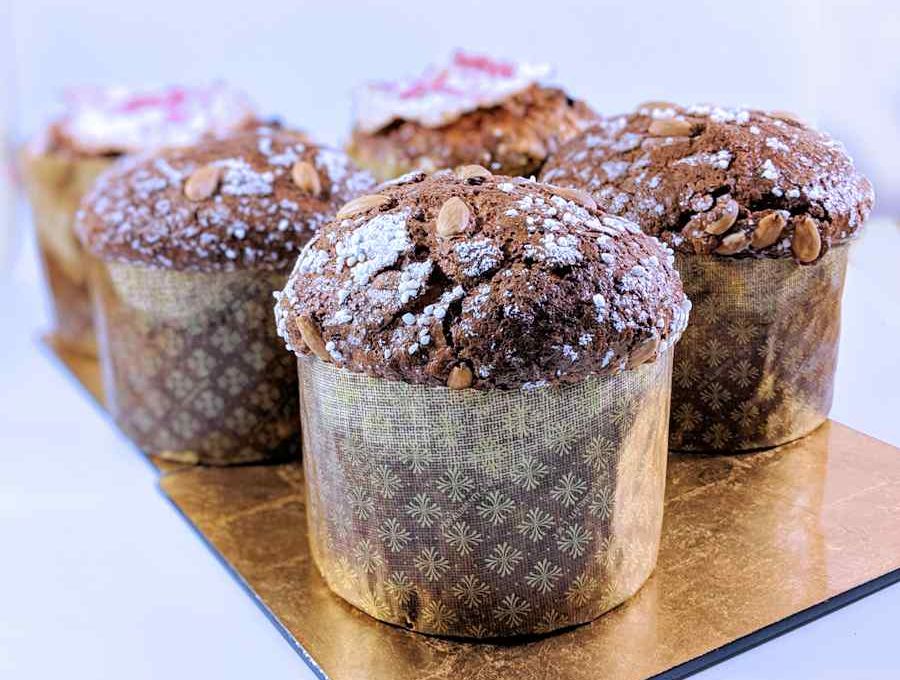The king of Christmas is traditional panettone made on lievito madre, ‘mother dough’. It requires considerable dedication, sacrifice and engineering nous to construct hanging apparatus for the panettoni.

This is a serious project so I’ll get to the heart of the matter without a preamble about random nonsense.
Easy panettone? No such thing!
You have to be patient. You have to have patience, lots of it. Patience, grasshopper. You need to be prepared to get up at 4am to feed your lievito madre or at most make do with 6 hours of sleep.
No going away for a week. Even going out is out of the question in the final days. You need a warm place in the house: an airing cupboard, an oven that will keep temperature as low as 30C, a warming drawer, a heating exchange cupboard or else you have to be living in Australia.
You need a standing mixer. You need panettone paper cases, 13cm or 16cm dia. You need bamboo skewers. You need to know what you’re doing with sourdough and have a sourdough starter on the go at 100% hydration. If I’ve lost you now, don’t go on (but do if you’re determined). Did I mention patience?
How long does it take?
Assuming you have a going sourdough starter (I should not recommend embarking on this project unless you have SOME sourdough experience at least), it takes 4-6 days to convert the starter to lievito madre. Remember the thing about not going away above?
The conversion means feeding the starter initially every 12 hours and every 4 hours for the last 24 hours. Sleep? Who needs to sleep if there’s panettone in the making?
The making of the actual dough starts at the end of the feeding frenzy, on the evening before The Baking Day. Yes, you can get some sleep that night - if you manage to nod off, with all the excitement.
Tips and things to remember
On the D-Day (P-Day?) make absolutely sure all the ingredients are at room temperature. You don’t want to spoil all the effort by dumping a fridge-cold egg into the sensitive dough.
There are five stages of making the main dough, each about adding ingredients in specific order and at precise quantities. No, I’m sorry – it’s not for those who slosh, dollop, drizzle and dust. Kitchen scales and an obsessive mind win – hence I’ve been reasonably successful at this panettone malarky.
Once the dough is made and shaped, there comes what I find the trickiest part: transporting the dough balls into the paper panettone cases. It’s very much like trying to shape slime!
The paper cases should be skewered with bamboo sticks, like rails. What’s that for? Why, that’s the best bit!
Why hang the panettone?
The construction skills mentioned above are also important because the fun thing in the final stage of panettone making is the hanging. In order to keep the air within the crumb, which is what makes it so Fluffy Central, and to stop it from escaping up and leaving collapsed sinkage behind, the breads need to be inverted upside down while cooling.
There are instructions below and ideas for the construction of the gallows. I have found (the hard way) that an extended clothes rack serves the purpose the best.
Bake the best panettone
I have now baked about 10 or 15 panettoni on natural starter and they have been pretty much all successful. I’m deeply indebted to Susan of Wild Yeast Blog (sadly now defunct, it seems), so if you’d rather get the instructions at source, off you go – I won’t be offended. If you stick around, I’ll be honoured.
Alternatives to panettone
No, it’s not ‘easy’ – ‘easy panettone’ is a fallacy and an oxymoron. But this is a very good one leavened on baker’s yeast. It only takes 18 hours from start(er) to finish!
An alternative to panettone altogether is pandoro. Also yeast-risen, deliriously rich but with zero raisin content – that’s why the Weather Man doesn’t care for it much.
A thoroughly decent Christmas bread which is not only doable but actually easy comes from Norway. Try julekake if I managed to put you off giving panettone a go.
Or you could throw in the towel and bake some mince pies instead!